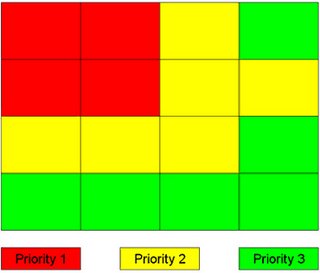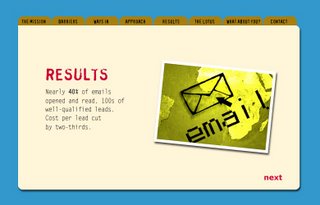The Worlds Quickest Introduction to
Copywriting for Direct Mail – Part 1:
It’s measurable
Direct mail is a subset of Direct Response Marketing. All forms of direct response, including direct mail give you results you can measure accurately. Image and awareness advertising – which you see so much of on TV – cannot do that.
Because direct mail is so measurable, it puts an onus on the copywriter to get it right. Fortunately, expert direct mail writers have tools and techniques that get results. Over the next few posts, I’m going to reveal some of those tools and techniques.
First, there are five key components to any direct response campaign, in any medium:
1. List – also known as target audience. This may be as broad as everyone who reads the Wall Street Journal, or watches Anderson 360, or as narrow as left-handed CEOs of biotech companies. How broad or narrow depends on what you are trying to sell, and the budget you have to acquire contact names.
2. Offer – Why should somebody buy this product or service from you. What’s in it for them? Special pricing? Two-for-one? Bonus add-ons? Longevity? More time off? Greater ability to concentrate? Tips for successful online marketing? What’s important is not your product or service, but its immediate and secondary benefits. The job of the Direct mail copywriter is to SELL THE OFFER, not the product.
3. Copy – we’ll get to that soon, but you need this background, first.
4. Graphics – This is what the designer does to make sure you get noticed, and that the reader’s eyes are directed through the piece to the point where you ask him or her to take action. Graphics should promote readability and reflect your brand or image.
5. Timing – Direct marketing guru Herschell Gordon Lewis says “Shoot while the ducks are flying.” Don’t try to sell snow tires in July or Bermuda shorts in January (unless they are part a cruise package to Bermuda). Much of timing is out of your control. You probably can’t sell to somebody who’s just been fired, and equally, not to someone who’s celebrating a promotion. You overcome bad personal timing through repeat mailings.
The 40-40-20 Rule says: 40% of your success comes from the list you use, 40% from the offer you make, and 20% from all the rest.
That’s enough background….
Part 2: Big Guns
The first rule for writing for direct mail was codified by Herschell Gordon Lewis who said: “Fire your big guns first.”
What does that mean? It means get to the point as fast as you can. You have somewhere between one second and 10 seconds to hook your audience, so don’t waste time warming up and don’t waste time talking about yourself. Talk about what your audience wants.
“At 21st Century Dietetics, we have over 25 years helping people like you lose weight.”
What’s wrong with that? Plenty. Nobody cares about the experience of 20th Century Dietetics – at least not at this point in the sales pitch. Also, what could be less specific than the proposition to “lose weight.”? The response from virtually any reader is going to be: “So what! Who cares?”
“Need to lose 20 lbs. before Christmas?”
Now, that’s better. It’s got specificity and a deadline. It’s got an implied you. You’re talking directly to the reader about something they want. It’s also got the nice, relaxed pattern of normal speech. And it’s economical – seven words instead of 15.
Here’s a secret: The goal of expert copywriters is to have their copy become invisible. You don’t want the reader overly aware that they are reading copy. You don’t want them stumbling over difficult words and awkward phrasings.
Which leads us to another important copywriting tip: write to the background, experience and expectations of your readers.
· If they are ordinary people, use ordinary words.
· It they are technical or scientific, throw in an aliquot of technical terms.
· If they are highly educated, a dash of elevated diction and syntax may be in order.
· But remember this, you can almost never go wrong being simple and direct, no matter who the reader is.
“Promise, large promise, is the soul of an advertisement,” said the 18th Century writer Samuel Johnson. When he was asked to auction off a brewery he remarked: “We are not here to sell boilers and vats, but the potentiality of growing rich beyond the dreams of avarice.”
Part 3: Five Motivators
Near the beginning I shouted: SELL THE OFFER.
What does that mean?
The offer is the theme of your communication. Begin with it. Restate it. Denote its key benefits. The actual product or service is largely incidental to your sales pitch.
Let’s go back to the weight loss example. Remember, the big gun you fired first was: “Want to lose 20 lbs before Christmas?”
At this point you could be selling diet pills, exercise equipment, a course in Pilates, motivational training or personal coaching. It’s appropriate now to tie your product to your offer:
Want to lose 20 lbs before Christmas?
On average, people who use the 21st Century Dietetics Method easily lose one pound of excess fat a week. Ask your dietician or doctor and they’ll tell you one pound a week is a safe, healthy amount of weight to lose.
Did you notice something? That’s right, the first paragraph consists of a single short sentence. The rule in firing your big gun is to keep your first sentence to 12 to 15 words, or less.
Another rule is: No long paragraphs. Keep your paragraphs down to 5 - 7 lines – which may equal only two or three sentences. And insert a space between paragraphs to break up your copy, making it look easy to read.
Herschell Gordon Lewis (him again!) says there are five main motivators to consider in your copy:
· Fear
· Greed
· Guilt
· Exclusivity
· Approval
Fear is the strongest, but also the trickiest, motivator, because it knocks people on their asses.
If you are 30 lbs or more overweight you are a prime candidate for colon cancer.
Scary stuff. Enough to put them off reading any further – until you quickly offer them a hand up:
But now there’s a weight loss supplement that contains a powerful, natural, cancer-fighting ingredient…
To find out more about motivators, buy a copy of Lewis’s On The Art of Writing Copy.
One last comment on writing direct mail copy. It’s not clever, witty, cute or funny. It’s selling, and it’s serious. As Lewis says: “In the age of skepticism, cleverness for its own sake may be a liability, rather than an asset.”
Or to put it another way: When’s the last time you bought anything from a clown.






























